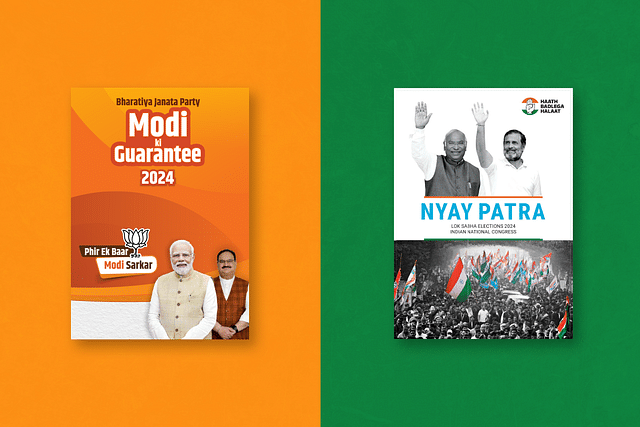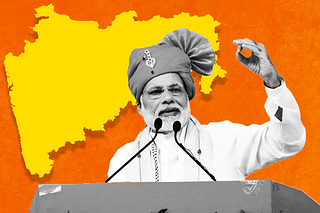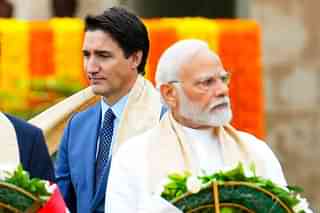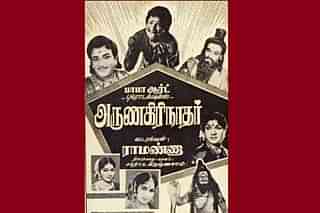Ideas
A Tale Of Two Manifestoes: The Good, Bad And Ugly Of Congress's Nyay And BJP's Sankalp Patra
R Jagannathan
Apr 15, 2024, 12:42 PM | Updated 12:41 PM IST
Save & read from anywhere!
Bookmark stories for easy access on any device or the Swarajya app.

Now that the ruling party, the Bharatiya Janata Party (BJP), has come out with its own election manifesto for the 2024 elections, it is time to compare it with the one put out by the Congress a week ago.
At first glance, the differences are so obvious that they bear repeating. The essential point of divergence is the BJP’s approach of empowerment in contrast with the Congress’s approach of entitlement. The BJP’s promises to voters include a few 'revdis' (freebies) while the Congress manifesto showers them from a helicopter without regard to resources.
Second, the BJP manifesto is driven by hope and aspiration. It asks voters to look at the larger picture beyond just their personal interests. While this has been the hallmark of the BJP since 2014, it has been particularly pronounced after the party asked for 'sabka prayas' (everybody’s efforts) after the 2019 electoral victory.
Over the last five years, the party has painted a picture of India becoming a developed country by 2047, by focusing on providing high quality social, physical and digital infrastructure, and making India a manufacturing hub.
The Congress manifesto, in sharp contrast, is driven by fear. Thus it emphasises threats to democracy, media and judicial autonomy, and emphasises wealth and income inequalities, among other things.
There are 'revdis' strewn everywhere, from the promise of Rs 1 lakh for women-led households to the right to first apprenticeship (again at Rs 1 lakh annually), higher minimum wages for MGNREGA work and for workers in general, offering legal guarantees for agricultural minimum support prices (MSPs), recruiting 30 lakh people to fill government job vacancies, and making constitutional changes to raise quotas in jobs beyond 50 per cent.
What divides the two manifestoes is not the details of each promise made, but a conflict of visions. Thomas Sowell, economist and public intellectual, wrote a book some time ago that at the core of every ideological battle since time immemorial lies a conflict of visions.
The current radical Left-liberal one is driven by the “unconstrained vision”, which holds that every human problem of inequity or injustice is solvable and hence it just needs more and more of something — money, power, or policy changes.
The other side is driven by what he calls the “constrained” vision, where the core assumption is that humans will usually be driven by self-interest and the resultant society will always be flawed. One can intervene to fix extreme inequity or self-evident problems, but the outcomes will still not give us a perfect society.
Broadly speaking, the Congress manifesto is driven by the first, 'unconstrained' vision, and the BJP’s by the second. Hence the Congress preference for endless freebies, while the BJP promises a helping hand so that the poor or the disadvantaged can lift themselves up. Hence the emphasis on greater access to credit, and not free cash.
The Congress approach is evident from the title of its manifesto (Nyay Patra). Its very first chapter focuses on 'equity', with segments on 'social justice', religious and linguistic minorities, LGBTQIA+ etc. The idea is to tap into the presumed underlying anger of the 'oppressed' and their innate fear of being left behind.
This strategy worked well in 2004, when the Atal Bihari Vajpayee government prematurely talked of India Shining, while the Congress talked of those whose lives were yet to shine. This time though, the Narendra Modi government has uplifted more lives, and one wonders if the same strategy will work for the Congress.
The BJP manifesto, in contrast, is called Sankalp Patra. It is a promise of delivery, or Modi Ki Guarantee 2024. The first chapter thus talks of what the party did in the last 10 years, and what it delivered.
The rest of the document paints a brighter future that every citizen is invited to make his or her own: the vision of a developed country, a manufacturing hub, a country which plays a larger role on the global stage and cultural rejuvenation.
There are some benefits promised to the poor, women, youth and agriculturists, but none of the promises are over-the-top. Every promise in the 24 chapters that follow the report card starts with a Modi ki guarantee for… the middle class, the young, the old, and so on.
Clearly, Modi sarkar believes in microeconomics and targeting specific voter bases, casting a net far and wide.
This is the point where we need to discuss the good, the bad and the ugly aspects of the Congress manifesto. The BJP manifesto does not need much discussion, for it promises no major new thing beyond what it has already been doing over the last decade — with line extensions.
The Congress manifesto has 10 chapters, starting with Equity, and followed by chapters on Youth, Women, Farmers, Workers, Defending the Constitution, Economy, Federalism, National Security and Environment. The BJP manifesto has 25 chapters, starting with a report card on 10 Years of Good Governance and Vikas, followed by 24 Modi Guarantees to segments starting with the Poor, Youth, Women and Farmers.
First the good parts. The best idea in the Congress manifesto is the promise of a 'right to apprenticeship'. The manifesto says that the party will, if elected, guarantee “a new right to apprenticeship act to provide a one-year apprenticeship with a private or a public sector company to every diploma holder or college graduate below the age of 25.
Apprentices will get Rs 1 lakh a year. The apprenticeship will impart skills, enhance employability and provide full-time job opportunities for millions of youth.”
No details have been spelt out, but the approach is broadly right, for skilling is best done in actual workplaces, and not just at educational institutions or skilling centres. If most of the money for apprenticeships will be given by the Centre, or along with states, employers will probably be willing to take more of them on.
But a downside will have to be handled: existing employees may not take kindly to being replaced over the medium term with lower-paid workers who are apprentices. The unions will have to be mollified, and it is far from certain that companies will take on full-time workers when technology offers useful alternatives to higher-cost labour. But the idea is worth trying.
Two other ideas I like are greater federalism, where the Congress offers to shift some of the powers in the concurrent list to states, and offering some share of goods and services tax (GST) revenues for local bodies, including municipalities.
It is urban areas which will create most of the jobs, and empowering them with more resources is vital for this project. Whether states will agree to giving more powers to urban bodies is another matter, but it is worth a try. An urban version of MGNREGA is another Congress idea worth trying, though how this will be funded is an open question.
Another reasonably good idea is to split the Supreme Court into two, one being a constitutional court, and the other being a final court of appeals for non-constitutional cases.
However, the initial idea of letting the seven senior-most judges become the constitutional court is bad in principle, for it would essentially recreate a seven-member collegium of judges who are senior, while the younger judges will decide appeals.
A better option would be to create separate streams for judges who will decide constitutional issues, and those who will implement the law as it stands without adding judicial interpretations. An even better idea would be to set up three final courts, with the third one specialising in commercial disputes.
The Supreme Court recently decided to overturn an earlier judgement awarding a lot of money to Reliance Infra from the Delhi Metro Rail Corporation, but clearly we cannot have commercial disputes being decided one way and then being reopened later.
How will commercial disputes ever end? More thought needs to go into this proposal to bifurcate the Supreme Court before it is implemented. Trifurcation, with a third wing specialising in commercial disputes, may be an idea worth trying.
There are several bad ideas in the Congress manifesto, many of them 'revdis'. The worst idea is free cash transfer of Rs 1 lakh per annum to poor women-led families.
One wonders if this is a modification of the NYAY (Nyuntam Aay Yojana) scheme announced before the 2019 elections, where Rahul Gandhi promised Rs 72,000 per annum to people in the bottom 20 per cent of the income pyramid.
Rs 1 lakh would thus be an inflation-adjusted equivalent of the NYAY scheme, but there are no hints in the manifesto on how this is to be funded, how the bottom of the pyramid households will be identified, and how soon the scheme will be rolled out.
Since the manifesto promises that the scheme will be rolled out in stages, one can presume that nothing much will happen in the initial years, but the scheme may be backloaded towards the 2029 elections. The economic impact will come in the years after that, but it is a bad idea nevertheless.
The Congress has also promised a legal guarantee for MSPs, ensuring a nightmare in implementing the idea over the whole country. Not just the cost, but the legal wrangles that follow may drive most private bulk purchasers out of the market.
Equally rash is the promise to fill 30 lakh job vacancies in the central government.
While some filling up may be warranted, there are two good reasons why so many job vacancies remain unfilled: first, when the state is busy doling out 'private goods' and freebies on scale, there is no money to take on long-term revenue burdens like full-time employees.
Second, in the era of digital technology, most lower-category jobs in government are essentially redundant. Consider why you need so many peons or office support staff when files can be moved electronically, and some work can be automated.
So, if the Congress does end up in power and actually fills up 30 lakh vacancies, it will end up bankrupting the government. And this when the next pay commission is sure to raise overall wage costs for all governments.
The Congress has effectively promised its own brand of vendetta politics. If elected, it will probe demonetisation, the electoral bonds scheme, Rafale, Pegasus spyware, and how economic offenders like Vijay Mallya and Nirav Modi were allowed to leave the country. In other words, it will be doing what it accuses the BJP of doing: selectively targeting the opposition.
The party promises to abolish the Agniveer scheme for a four-year tour of duty in the armed forces, when the scheme has barely been implemented. It is always a bad idea to junk a scheme before it has had a chance to play itself out. A better idea would be to review the scheme after its first four-year rollout, and modify it to make it better.
The most dubious aspect of Congress’s manifesto is what it promises minorities — freedom of choice in matters of dress, food, love and personal laws. While dress is less of an issue — at worst it may involve allowing girls to wear hijabs to schools — food and personal laws are a completely different matter.
If one is free to eat what food one chooses, is this a hint that the ban on cow slaughter will be reversed? If personal laws are to be retained, it means no uniform civil code.
This is the ugliest part of the manifesto, where the Congress reaffirms white lies as part of appeasement politics. It says that it will “ensure that, like every citizen, minorities have the freedom of choice of dress, food, language and personal laws.”
Really, which other citizens, apart from minorities, have the right to run their own institutions, places of worship or personal laws?
Do Hindus have a right to personal laws? Are Muslims and Christian places of worship forced to endure state intervention? So where is the need to pretend that these rights of minorities are available to 'every citizen'?
Then there is the promise of a caste census, a move that will badly divide society further — especially Hindu society. It can benefit only minorities.
The Congress manifesto can best be described as a dishonest one, a manifesto designed to promise the moon to its key voter segments at the cost of the nation. It will not end well.
Save & read from anywhere!
Bookmark stories for easy access on any device or the Swarajya app.
Jagannathan is Editorial Director, Swarajya. He tweets at @TheJaggi.
Introducing ElectionsHQ + 50 Ground Reports Project
The 2024 elections might seem easy to guess, but there are some important questions that shouldn't be missed.
Do freebies still sway voters? Do people prioritise infrastructure when voting? How will Punjab vote?
The answers to these questions provide great insights into where we, as a country, are headed in the years to come.
Swarajya is starting a project with an aim to do 50 solid ground stories and a smart commentary service on WhatsApp, a one-of-a-kind. We'd love your support during this election season.
Click below to contribute.





